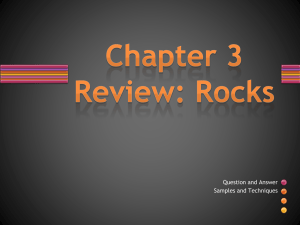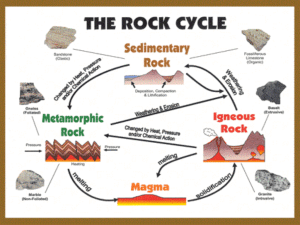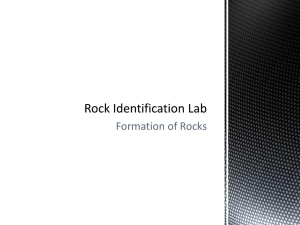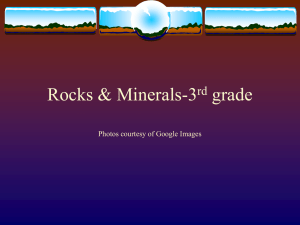Rocks and the Rock Cycle powerpoint
advertisement
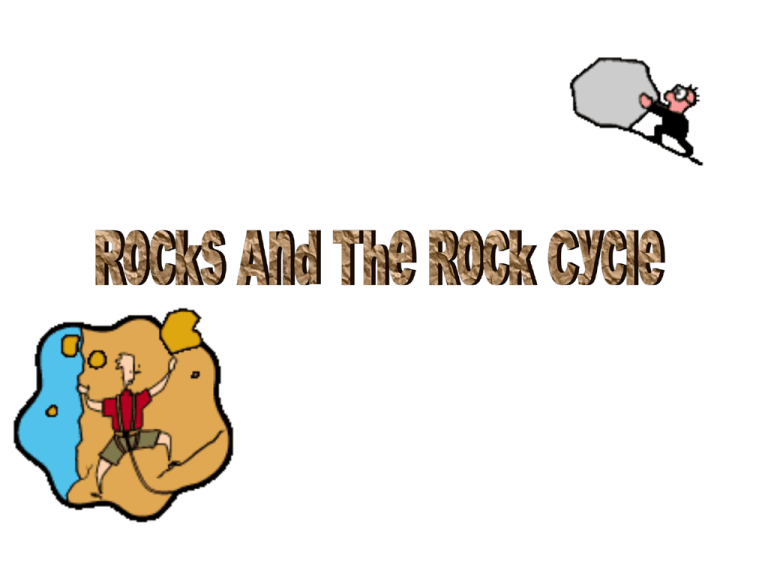
Buildings Roads Bridges Concrete Extract minerals – like iron (Fe) to make steel Toothpaste Salt Sandpaper Decorations Jewelry 1. Why is it important to have a basic understanding of the rock cycle? Rocks contain clues about the environment. Helps us understand the formation of the earth. 2. Rock Any solid mass of minerals or mineral-like matter 3. Do most rocks occur as one mineral or as a mixture of minerals? 4. Some rocks are made of nonmineral material, can you name one? Coal - begins as layers of plant matter accumulate at the bottom of a body of water. For the process to continue the plant matter must be protected from biodegradation and oxidization, usually by mud or acidic water. This trapped atmospheric carbon in the ground in immense peat bogs that eventually were covered over and deeply buried by sediments under which they metamorphosed into coal. Over time, the chemical and physical properties of the plant remains (believed to mainly have been fern-like species antedating more modern plant and tree species) were changed by geological action to create a solid material. Coal, a fossil fuel, is the largest source of energy for the generation of electricity worldwide. 5. Explain the rock cycle. A continuous process that causes rock to change from one form to another 2 1 3 5 4 The Rock Cycle is a group of changes, this change does not necessarily have to be a chemical change. Igneous rock can change into sedimentary rock or into metamorphic rock. Sedimentary rock can change into metamorphic rock or into igneous rock. Metamorphic rock can change into igneous or sedimentary rock. Almost all of rock today that we have on earth is made up of all the same stuff as the rocks that dinosaurs and other ancient life forms walked, crawled, or swam over While the stuff that rocks are made of has stayed the same, the rocks themselves, have not Over time rocks are recycled into other rocks Moving tectonic plates are responsible for destroying and forming many types of rocks 6. List the 3 types of rocks 7. Igneous Rocks Igneous rock forms when magma cools and makes crystals. Magma is a hot liquid made of melted minerals. When magma pours onto the earth’s surface it is called lava. The minerals can form crystals when they cool. Igneous rock can form underground, where the magma cools slowly. Or, igneous rock can form above ground, where the magma cools quickly. The crystals grow together and form one igneous rocks. 8. What kind of igneous rocks form when molten lava cools and hardens? Extrusive = forced out while molten through cracks in the earth's surface 9. What is the Latin word that the word igneous comes from and what does it mean? ignis = fire 10. Intrusive Igneous Rocks Form from magma below the earth’s surface 11. Extrusive Igneous Rocks Formed by lava on the Earth’s surface 12. What is the difference between magma and lava? Magma = molten rock below the earth’s surface Lava = molten rock flowing on the earth’s surface 13. What are the 8 elements that make up magma? Silicon, oxygen, aluminum, iron, calcium, sodium, potassium, magnesium Look at the granite rock (A on age 71) and the rhyolite rock (B on page 71) Granite Rhyolite 14. In what ways are the two rocks similar? Both are from melted rock Their composition is the same 15. In what ways are the two rocks different? Granite Rhyolite Granite – coarse texture, made from magma Rhyolite – fine texture, made from lava 16. What causes the two rocks to be different? Granite Rhyolite Granite – Slow cooling below the earth’s surface Rhyolite – Quick cooling on the earth’s surface 17. Why do you think some rocks are heavier than others? Some are denser – less air space between particles Which rock would have greater density? Pumice Granite Classifying Rocks Rocks can be classified, or put into groups with similar characteristics, by looking at the rocks texture, mineral composition, and color. 18. What is texture? The size, shape, and pattern of the rock’s grain Glassy (nice) 19. Composition (what’s it made of?) The minerals that make up the different parts of a rock Examples: Quartz Feldspar Magnesium Iron ADD Rock Color The apparent color of the rock, on the inside and the outside 20. Slow cooling magma will form rocks with a a. coarse grained texture. b. fine grained texture. c. glassy texture. d. porphyritic texture. 21. Rapid cooling magma will form rocks with a a. coarse grained texture. b. fine grained texture. c. glassy texture. d. porphyritic texture. 22. When lava spews onto the earth’s surface rocks will form with a a. coarse grained texture. b. fine grained texture. c. glassy texture. d. porphyritic texture. 23. Magma that is located deep within the earth may take tens of thousands of years to harden. The rocks that form in this case will have a a. coarse grained texture. b. fine grained texture. c. glassy texture. d. porphyritic texture. 24. Which 2 minerals are granitic rocks composed of? Quartz Feldspar 25. Which 2 minerals are basaltic rocks composed of? Magnesium Iron Metamorphic rocks are rocks that have "morphed" into another kind of rock. These rocks were once igneous or sedimentary rocks. How do sedimentary and igneous rocks change? The rocks are under tons and tons of pressure, which fosters heat build up, and this causes them to change. If you exam metamorphic rock samples closely, you'll discover how flattened some of the grains in the rock are. Rock divisions occur in three major families based on how they formed: igneous, sedimentary, and metamorphic. Each group contains a collection of rock types that differ from each other on the basis of the size, shape, and arrangement of mineral grains. Just remember 3 types of rocks=3 divisions. (igneous, sedimentary, and metamorphic) When classifying a rock sample geologists observe the rock’s color and texture and determine its mineral composition. Texture: the size, shape, and pattern of the rock’s grain. Color: the apparent color of the rock, on the inside and the outside. Mineral composition: The minerals that make up the different parts of a rock. Texture: Grain Size Often, the grains in a rock are large and easy to see. Such rocks are said to be coarse-grained. In other rocks, the grains are so small that they can only be seen with a microscope. These rocks are said to be fine-grained. Notice the difference in texture between the fine-grained slate and the coarse-grained diorite to the right. Texture: Grain Shape • • • • The grains in a rock vary widely in shape Some grains look like tiny particles of fine sand Others look like small seeds or exploding stars In some rocks, such as granite, the grain results from the shapes of the crystals that form the rock • In other rocks, the grain shape results from fragments of other rock • These fragments can be smooth and rounded, like the fragments in conglomerate, or they can be jagged, like the fragments in breccia • You can compare conglomerate and breccia one the next slide Texture : Grain Pattern • The grains in a rock often form patterns. Some grains lie in flat layers that look like a stack of pancakes. • Other grains form wavy, swirling patterns. Some rocks have grains that look like rows of multicolored beads, as in the sample of gneiss shown above. • Other rocks, in contrast, have grains that occur randomly throughout the rock. Different Types of Texture Fine-Grained, Coarse-Grained, Rounded Grain, Jagged Grain, Nonbanded, Banded 2 Types of Igneous Rocks INTRUSIVE IGNEOUS ROCKS – When igneous rocks are formed by magma that cools BENEATH Earth’s surface, they are called intrusive igneous rocks EXTUSIVE IGNEOUS ROCKS – When igneous rocks are formed by LAVA ON Earth’s surface, they are called extrusive igneous rocks Lithification • The process by which sediment becomes sedimentary rock • 1st step : erosion • 2nd step : deposition • 3rd step : compaction • 4th step : cementation Sedimentary Rocks : Erosion Destructive forces are constantly breaking up and wearing away all the rocks on Earth’s surface The forces include heat and cold, rain, waves, and grinding ice Erosion occurs when running water or wind loosens and carry away the fragments of rock. Sedimentary Rocks: Deposition Eventually, the moving water or wind slows and deposits the sediment. If water is carrying the sediment, rock fragments and other materials sink to the bottom of a lake or ocean. Deposition is the process by which sediment settles out of the water or wind carrying it. After sediment has been deposited, the processes of compaction and cementation change the sediment into sedimentary rock. In addition to particles of rock, sediment may include shells, bones, leaves, stems, and other remains of living things. Over time, any remains of living things in the sediment may slowly harden and change into fossils trapped in the rock. Sedimentary Rocks: Compaction At first the sediments fit together loosely. But gradually, over millions of years, thick layers of sediment build up. These layers are heavy and press down on the layers beneath them. Then compaction occurs. Compaction is the process that presses sediments together. Year after year more sediment falls on top, creating new layers. The weight of the layers further compacts the sediments, squeezing them tightly together. The layers often remain visible in the sedimentary rock. Sedimentary Rocks: Cementation While compaction is taking place, the minerals in the rock slowly dissolve in the water. The dissolved minerals seep into the spaces between particles of sediment. Cementation is the process in which dissolved minerals crystallize and glue particles of sediment together. It often takes millions of years for compaction and cementation to transform loose sediments into solid sedimentary rock. Sedimentary Transformations Point A: water or wind deposits sediments Point B: The heavy sediments press down on the layers beneath Point C: Dissolved minerals flow between the particles and cement them together Metamorphic Rock Pictures Granite, Gneiss, Shale, Slate, Sandstone, and Quartzite are good examples of metamorphic rocks. Bet Cha’ Weren’t Expecting A…. POP QUIZ!!!!!* 1. What are the three types of rock? 2. Which type of rock has been formed by magma or lava? 3. What do we classify rocks by? 4. How do sedimentary rocks form (in order)? 5. Metamorphic rocks are rocks that have ?(fill in the blank) 6. What is the process of sediments forming a sedimentary rock? 7. What does “ignis” mean in the word igneous? *Answers are on next slide! ANSWERS!!!! 1. 2. 3. 4. Igneous, Sedimentary, and Metamorphic Igneous Texture, Color, and Mineral Composition Erosion, Deposition, Compaction, Cementation 5. Morphed 6. Lithification 7. “ignis” means fire www.dlese.com Earth Science Textbook Google Images ( I KNOW THIS DOESN’T COUNT IM JUST TELLING YOU!!) http://www.rocksandminerals.com/rockcycl e.htm Sedimentary rocks form from particles deposited by water and wind If you have ever walked along a beach (which I am sure you have) you may have noticed tiny sand grains, mud, and pebbles. These are some sediments that eventually form into sedimentary rocks Sedimentary Rocks can form in 4 ways by: Erosion Deposition Compaction Cementation



